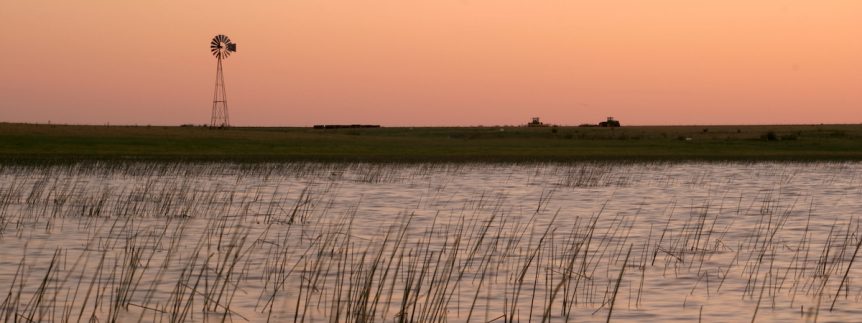Read the Transcript
Researchers are constantly providing new information that the playa lakes of the high plains region are more beneficial to the future of our groundwater supply than was previously understood. When we can take steps to increase the amount of recharge to the aquifer, it benefits dryland farmers and ranchers, but also towns and cities that rely on well water.
Randy Stotler’s a hydrogeologist at University of Kansas. He studies the playas of western Kansas.
Not only do playa lakes provide aquifer recharge, they are capable of recharging the groundwater enough to provide a sustainable amount of water for dryland farming and ranching.
“Some research that I’ve done, and others in the last 10 years or so, has shown that playas can actually provide faster recharge rates to the aquifer than even under an irrigated center pivot. So, they can be quite significant in terms of the recharge they are providing to the aquifer.”
Researchers say firm data on the actual amount of aquifer recharge playas can provide is extremely variable, as might be expected. It depends on the size of a playa when it’s wet, how often the playa’s holding water, soil type, and depth to the water table.
“We’re actively trying to understand their role and the amount of recharge that we can get into the aquifers, and how much water is actually there and available for use.”
Not only do playa lakes provide the aquifer recharge, researchers are coming around to the idea playas are capable of recharging the groundwater enough to provide a sustainable amount of water for dryland farming and ranching.
“I certainly agree with that conclusion. The amount of water that is being pulled out of the aquifer for irrigation is much greater than we can expect to see recharged through any individual playa or group of playas, but it can certainly sustain a less water intensive operation such as dryland farming or ranching.”
That’s important new information, as communities struggle to deal with declining aquifers and cyclical droughts.
I ran some numbers with Andy Weinberg, a geoscientist with the Texas Water Development Board. He studies the playas of west Texas. He says some of them can collect a foot and a half of water per year, per acre.
“If you have a playa that is 50 to 100 acres, you’re talking 150 acre-feet a year that may be collected in it.”
So, says Weinberg, on average maybe a quarter of that water infiltrates the soil. Maybe that adds up to a dozen acre-feet of water a year.
“For an irrigator, that’s pretty trivial. But if you’re trying to do a household water supply, water your herd of cattle or something like that, that’s plenty of water to make that a sustainable operation.”
Think about the implication, for a dryland producer who’s adopting sustainable practices, and for ranchers.
Healthy playa lakes can provide sufficient recharge to give the farmstead the expectation of groundwater into the foreseeable future. Of course, that assumes a healthy playa — a playa that isn’t farmed through, a playa that hasn’t been impeded by siltation, and a playa with a grass buffer to hold back the silt and filter contaminants in the runoff.
Not only does the healthy playa’s natural hydrologic mechanism recharge the aquifer, the quality of the water also is improved.
Playas reduce nitrate concentrations. Nitrates are a common contaminant in the groundwater of agricultural areas. Nitrates are an important component in fertilizers, and they’re present in animal manure and septic systems.
“Nitrates will break down in the absence of oxygen. One of the things about playas with the heavy clay soil that they have, when that’s all saturated, the oxygen all gets pulled out of the system. As water moves through the cracks in the clay, the nitrate gets reduced back down to nitrogen and it’s lost out of the system. That’s important for having a good water quality; high nitrates are detrimental to human health.”
A healthy playa lake is a primary way groundwater is replenished by surface water. And a playa lake with a perimeter plant buffer traps sediments and improves the quality of water as it moves to the aquifer below.
Playa Country, which ended in late 2016, was a weekly show that featured conservation and wildlife experts — as well as farmers, ranchers and land managers — talking about conservation practices that improve wildlife habitat and landowners’ bottom-line. This episode of Playa Country was made possible by Playa Lakes Joint Venture and a grant from the Wildlife Conservation Society with support provided by the Doris Duke Charitable Foundation.

